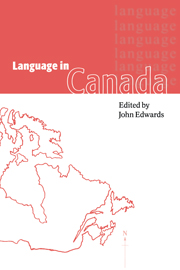Book contents
- Frontmatter
- Contents
- List of figures
- List of maps
- List of tables
- Notes on contributors
- 1 Canada
- Introduction
- 1 The foundations
- 2 The fading Canadian duality
- 3 Official bilingualism: from the 1960s to the 1990s
- 4 Official multiculturalism
- 5 Language in education: bridging educational policy and social psychological research
- 6 Aboriginal languages: history
- 7 Aboriginal languages: current status
- 8 French: Canadian varieties
- 9 French in Quebec
- 10 French in New Brunswick
- 11 French outside New Brunswick and Quebec
- 12 English: Canadian varieties
- 13 English Quebec
- 14 The teaching of international languages
- 15 French immersion in Canada
- 16 Language in Newfoundland
- 17 Language in Prince Edward Island
- 18 Language in Nova Scotia
- 19 Language in New Brunswick
- 20 Language in Quebec: aboriginal and heritage varieties
- 21 Language in Ontario
- 22 Language in Manitoba
- 23 Language in Saskatchewan: Anglo-hegemony maintained
- 24 Language in Alberta: unilingualism in practice
- 25 Language in British Columbia
- 26 Language in the Northwest Territories and the Yukon Territory
- Index of names
- Index of language families, languages, dialects
- Index of subjects
3 - Official bilingualism: from the 1960s to the 1990s
Published online by Cambridge University Press: 18 February 2010
- Frontmatter
- Contents
- List of figures
- List of maps
- List of tables
- Notes on contributors
- 1 Canada
- Introduction
- 1 The foundations
- 2 The fading Canadian duality
- 3 Official bilingualism: from the 1960s to the 1990s
- 4 Official multiculturalism
- 5 Language in education: bridging educational policy and social psychological research
- 6 Aboriginal languages: history
- 7 Aboriginal languages: current status
- 8 French: Canadian varieties
- 9 French in Quebec
- 10 French in New Brunswick
- 11 French outside New Brunswick and Quebec
- 12 English: Canadian varieties
- 13 English Quebec
- 14 The teaching of international languages
- 15 French immersion in Canada
- 16 Language in Newfoundland
- 17 Language in Prince Edward Island
- 18 Language in Nova Scotia
- 19 Language in New Brunswick
- 20 Language in Quebec: aboriginal and heritage varieties
- 21 Language in Ontario
- 22 Language in Manitoba
- 23 Language in Saskatchewan: Anglo-hegemony maintained
- 24 Language in Alberta: unilingualism in practice
- 25 Language in British Columbia
- 26 Language in the Northwest Territories and the Yukon Territory
- Index of names
- Index of language families, languages, dialects
- Index of subjects
Summary
While Canada's federal system could lay claim to some elements of a language policy before the 1960s, the content of this policy was quite narrow. It consisted mainly in guarantees of rights to use English and French in the federal Parliament, federal courts, the Quebec legislature and Quebec courts. The vast bulk of citizen contacts with federal authorities was untouched by law or regulation. In the 1960s, this situation would change. A primary reason was the ‘Quiet Revolution’ in Quebec, which not only transformed and modernized society, but also led to fundamental questioning of the position of Quebec in Canada and of the language situation in both these jurisdictions. In a wider sense, the decade of the 1960s was a period of rapidly expanding contacts between citizens and governments throughout Canada because of an expanding welfare state.
THE ROYAL COMMISSION ON BILINGUALISM AND BICULTURALISM
When the Liberals returned to power after the federal general election of 1963, one of the first acts of the Pearson government was to establish a Royal Commission on Bilingualism and Biculturalism to study these growing linguistic and political strains in some depth. Also known as the Laurendeau–Dunton Commission, it was one of a series of large-scale public policy investigations that have marked the Canadian political landscape (beginning with the landmark Rowell–Sirois Royal Commission on Dominion–Provincial Relations of 1937).
- Type
- Chapter
- Information
- Language in Canada , pp. 61 - 83Publisher: Cambridge University PressPrint publication year: 1998
- 3
- Cited by



